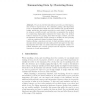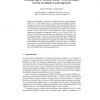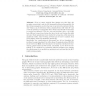106
Voted
PKDD
2010
Springer
14 years 11 months ago
2010
Springer
Abstract. One of the key problems in model-based reinforcement learning is balancing exploration and exploitation. Another is learning and acting in large relational domains, in wh...
PKDD
2010
Springer
14 years 11 months ago
2010
Springer
113
Voted
PKDD
2010
Springer
14 years 11 months ago
2010
Springer
Current knowledge bases suffer from either low coverage or low accuracy. The underlying hypothesis of this work is that user feedback can greatly improve the quality of automatica...
135
click to vote
PKDD
2010
Springer
14 years 11 months ago
2010
Springer
One of the major strengths of probabilistic topic modeling is the ability to reveal hidden relations via the analysis of co-occurrence patterns on dyadic observations, such as docu...
131
Voted
PKDD
2010
Springer
14 years 11 months ago
2010
Springer
Abstract. A new method is proposed for compiling causal independencies into Markov logic networks (MLNs). An MLN can be viewed as compactly representing a factorization of a joint ...
91
Voted
PKDD
2010
Springer
14 years 11 months ago
2010
Springer
Abstract. For a book, the title and abstract provide a good first impression of what to expect from it. For a database, getting a first impression is not so straightforward. Whil...
PKDD
2010
Springer
14 years 11 months ago
2010
Springer
Abstract. We present an automated tool with a web interface for tracking the prevalence of Influenza-like Illness (ILI) in several regions of the United Kingdom using the contents...
116
Voted
PKDD
2010
Springer
14 years 11 months ago
2010
Springer
Multi-task learning leverages shared information among data sets to improve the learning performance of individual tasks. The paper applies this framework for data where each task ...
106
Voted
PKDD
2010
Springer
14 years 11 months ago
2010
Springer
In this paper, we introduce a simple but efficient greedy algorithm, called SINCO, for the Sparse INverse COvariance selection problem, which is equivalent to learning a sparse Ga...
103
Voted
PKDD
2010
Springer
14 years 11 months ago
2010
Springer
Given a contact network that changes over time (say, day vs night connectivity), and the SIS (susceptible/infected/susceptible, flu like) virus propagation model, what can we say ...





